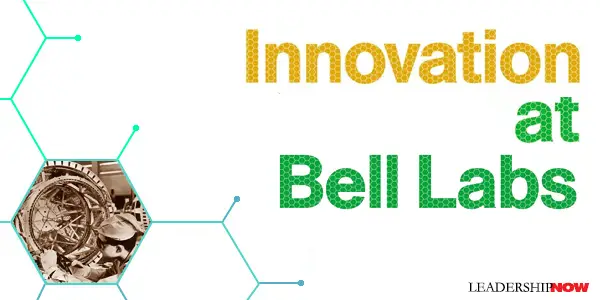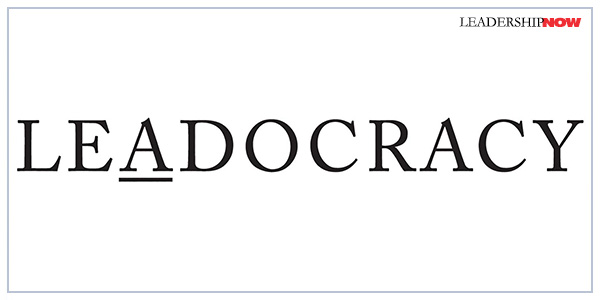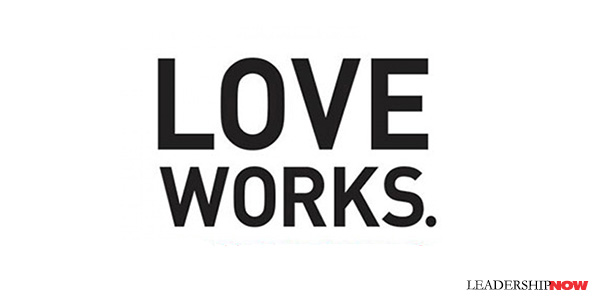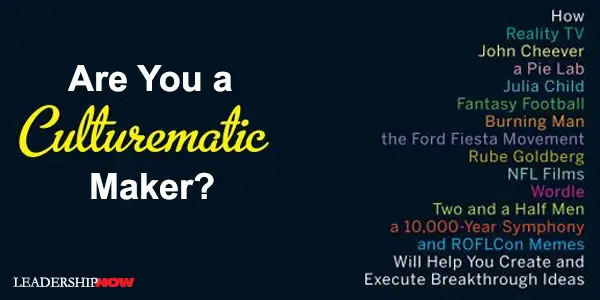 Leading Blog | Posts by Month |
 Leading Blog | Posts by Month |
06.30.12

LeadershipNow 140: June 2012 Compilation
Posted by Michael McKinney at 01:00 AM
06.28.12

Innovation at Bell Labs
BILL GATES once remarked, “My first stop on any time-travel expedition would be Bell Labs in December 1947,” That was the year Bell Labs invented the transistor—a tiny invention that makes possible the technology we have today. Finding an aspect of modern life that doesn’t incorporate some strand of Bell Labs’ DNA would be difficult. Cellular communications, the laser, digitized and synthesized music, the solar battery cell, the first orbiting communications satellite, and the UNIX operating system, are all products of Bell Labs. AT&T officially created Bell Telephone Laboratories on January 1, 1925. At its peak in the late 1960s’, Bell Labs employed about twelve-hundred PhDs and produced 13 Nobel Prize winners.
 John Pierce is one of the brilliant and interesting people we are introduced to in Gertner’s story. It was Pierce that suggested calling the new device of 1947 a transistor. Peirce was what Gertner calls an instigator. “An instigator is different from a genius, but just as uncommon. An instigator is different, too, from the most skillful manager, some able to wrest excellence out of people who might otherwise fall short.” Pierces real talent was “in getting people interested in something that hadn’t really occurred to them before.” Humans all suffer from a terrible habit of shoving new ideas into old paradigms. “Everyone faces the future with their eyes firmly on the past and they don’t see what’s going to happen next,” observed John Pierce. For creativity to flourish, it needs both freedom and structure. When pierce first came to Bell Labs “he was given free rein to pursue any ideas he might have. He considered the experience equivalent to being cast adrift without a compass. ‘Too much freedom is horrible,’ he would say in describing his first few months at the Labs. Indeed he eventually came to believe that freedom in research was similar to food; it was necessary, but moderation was usually preferable to excess.” Gertner writes, “We usually imagine that invention occurs in a flash, with a eureka moment that leads a lone inventor toward a startling epiphany. In truth, large leaps forward in technology rarely have a precise point of origin. At the start, forces that precede an invention merely begin to align, often imperceptibly, as a group of people and ideas converge, until over the course of months or years (or decades) they gain clarity and momentum and the help of additional ideas and actors. Luck seems to matter, and so does timing, for it tends to be the case that the right answers, the right people, the right place—perhaps all three—require a serendipitous encounter with the right problem. And then—sometimes—a lead. Only in retrospect do such leaps look obvious. When Niels Bohr—along with Einstein, the world’s greatest physicist—heard in 1938 that splitting a uranium atom could yield a tremendous burst of energy, he slapped his head and said, ‘Oh, what idiots we have all been.’” Today there is nothing quite like the Bell Labs of AT&T and Western Electric to produce the creative technology that they did. Bell Labs laser scientist Herwig Kogelnik describes the magic of Bell Labs well: “It’s the interaction between fundamental science and applied science, and the interface between many disciplines, that creates new ideas.” 

Posted by Michael McKinney at 04:54 PM
06.25.12

Leadocracy
RECENT POLLS reveal that most of us – 88% – think that government is broken. We lack confidence in the people who run for or serve in office. Geoff Smart says we have a who problem. In Leadocracy he writes that the only way to fix the what problems—the deficit, unemployment, and insufficient social services to name a few—is to get the right who into government. Smart finds that there is a huge untapped source of potential leaders in the private sector—if they would just step up. But they don’t—in droves—because of fear. Fear of not being able to make a difference, fear of the financial and psychological costs, and fear of public scrutiny. But they should for three reasons, says Smart. First, a leadership role in government is a new challenge and an opportunity to grow your leadership skills. Second, because you can make a difference, that is enormously satisfying. And third, in government, you interact with an amazing range of people—you build relationships, help them in ways only you can, and become part of a broader community that is making people’s lives better. Smart founded The Leaders Initiative with the goal of having 1500 private sector leaders complete a two-year stint in government (local, state, or federal) by 2030. The hope is that it will have a positive multiplier effect on encouraging more private sector leaders to consider “government leadership” in their career plan. Smart states, “Democracy works best when voters choose great candidates.” It seems like a simple statement, but it explains a lot. He says we are not very good at it. He does offer some tools and tips for determining how qualified a candidate is for the task at hand, and ensuring you are “hiring” the best leader for the job. He hopes we can reverse our tendency to: • place too much emphasis on likeability
I would agree with Smart. However, I would add that government isn’t broken because, in most cases, its leaders lack ideas, are bad people, bad leaders, stupid, incompetent, or just a bunch of amateurs. It’s broken because they are in a system that rewards them for pandering to their constituents. It’s how many of them keep their jobs. It would be a mistake to think that somehow government got all of the bad leaders and the private sector is hoarding them—and if we could flip-flop the situation, the problem would be solved. It’s a systemic problem. We see leaders in government that should know better, giving people what they want not because it is the best option for their constituents but because they want the votes to keep them in office. They effectively stop leading. We do have a who problem. But realistically it is not just a matter of getting the “good people” in. It will take a tremendous amount of fortitude for anyone wishing to serve in government to take the time to educate instead of pander, to do the hard things rather than the expedient, to lead rather than follow, to stand on character instead of popularity. But then, we would probably vote them out. So the issue is something we have to remedy within ourselves too. It’s also an issue the Founding Fathers didn’t think we should take lightly. 
Posted by Michael McKinney at 12:11 AM
06.21.12

Love Works
WE’VE heard that love is the killer app from Tim Sanders and Mark Sanborn says that “when we allow love to define who we are as we work, we become irresistible leaders with a contagious passion for what we do.” Joel Manby says that Love Works, but it’s hard. On the other hand, easy doesn’t get it done. It’s easier to “hit the numbers” than to worry about how our decisions impact the lives of others. It’s easier to fire someone than to work with them. But easier doesn’t build trust, it doesn’t grow and nurture a strong culture that brings out the best in people, and it doesn’t build a lasting, healthy organization that attracts the very best and stands the test of time. Leading with love is a higher testament to one’s leadership acumen than simply taking the well-trodden path toward fear-based, power-hungry management. Leading with love demands commitment, strong will, and patience, but the results are second to none. Manby says love is an action and not a feeling. He identifies seven behaviors: to be patient, kind, trusting, unselfish, truthful, forgiving, and dedicated. These are the bottom-line behaviors for leading with love. Leading with love is a lifestyle choice, says Manby, and should be part of what he calls your be goals as opposed to your do goals. Your be goals are completely within your power to execute. How will you lead? 
Posted by Michael McKinney at 11:23 PM
06.19.12

Are You a Culturematic Maker?
A Culturematic, says author and anthropologist, Grant McCracken, is a little machine for making culture. It is an exercise in edge finding. But at the same time, a Culturematic must speak to us. It must make us go, “Hmm, that’s interesting.” A Culturematic is also an attitude of mind that goes beyond the box of ordinary thinking “not because it is mischievous to do so, but because there might be a world out there and it might be interesting to find out what this world is.” McCracken says that because we live in a world of constant change and because we must adapt to it with an experimental stream of new ideas, we need Culturematics. It is when the problem is too complex or difficult and the solution is not forthcoming that Culturematics shine. Culturematics aren’t sure where they are going. When we aren’t sure what we’re looking at but think, “I’ll know it when I see it,” then we need ideas we can’t possibly guess we will need. “The trick,” says McCracken, “is to invent our own serendipity, to establish a cloud of possibilities in which we can spot the telling pattern.” Start a Culturematic by asking “what if?” Then, try it. The result should discover and distribute meaning. It helps us to see ourselves or something in the world, differently. It should also unleash value—even repurposing value; discovering “value in the artifact the maker does not know is there.” “Culturematics manage a tension between the order of the starting point and the unpredictability and disorder of the ending point.” This is not to say that we point a Culturematic in any direction and pull the trigger. A Culturematic is working with the culture that is already in place, so we point it in the direction where we think we might be able to create meaning and value. Culturematics... • start playing in our heads immediately. They capture our attention.
Fantasy Football, Twitter, and Reality TV are just a few of the examples of Culturematics discussed in the book. More can be found at the Culturematic Pinterest site. Culturematic is not based on entirely new ideas. However, it will not only make you look at the world (and what you are doing) differently, but you will develop a new appreciation for what you see, feel, and think. McCracken explains how to Culturematic yourself or your organization. Worth the read if you’re trying to create meaning and value in the world. 
Posted by Michael McKinney at 05:21 PM
06.17.12

A Father's Advice: F. Scott Fitzgerald on What to Worry About  DEAR PIE: I feel very strongly about you doing duty. Would you give me a little more documentation about your reading in French? I am glad you are happy--but I never believe much in happiness. I never believe in misery either. Those are things you see on the stage or the screen or the printed page, they never really happen to you in life. All I believe in in life is the rewards for virtue (according to your talents) and the punishments for not fulfilling your duties, which are doubly costly. If there is such a volume in the camp library, will you ask Mrs. Tyson to let you look up a sonnet of Shakespeare's in which the line occurs Lilies that fester smell far worse than weeds.... Half-wit, I will conclude. Things to worry about: Worry about courage Worry about Cleanliness Worry about efficiency Worry about horsemanship Worry about… Things not to worry about: Don’t worry about popular opinion Don’t worry about dolls Don’t worry about the past Don’t worry about the future Don’t worry about growing up Don’t worry about anybody getting ahead of you Don’t worry about triumph Don’t worry about failure unless it comes through your own fault Don’t worry about mosquitoes Don’t worry about flies Don’t worry about insects in general Don’t worry about parents Don’t worry about boys Don’t worry about disappointments Don’t worry about pleasures Don’t worry about satisfactions Things to think about: What am I really aiming at? How good am I really in comparison to my contemporaries in regard to: (a) Scholarship (b) Do I really understand about people and am I able to get along with them? (c) Am I trying to make my body a useful instrument or am I neglecting it? With dearest love,
Posted by Michael McKinney at 01:22 PM
06.15.12

What’s Wrong with Leadership Training Today? IT’S A DIFFICULT TIME for leaders. “Our familiarity with and disrespect for our leaders,” writes Harvard professor, Barbara Kellerman in The End of Leadership, “coupled with our feeling entitled and being emboldened, saps their authority, which then drains their power and influence.”
IT’S A DIFFICULT TIME for leaders. “Our familiarity with and disrespect for our leaders,” writes Harvard professor, Barbara Kellerman in The End of Leadership, “coupled with our feeling entitled and being emboldened, saps their authority, which then drains their power and influence.”
Commenting on the 2011 budget-ceiling talks she finds that Barack Obama’s followers are “more disposed to resist him than to support him….No one was able to lead…and no one was willing to follow.” Perhaps no one was able to lead because no one was willing to follow. Leading in America is now more difficult than ever “not only because we have too many bad leaders, but because we have too many bad followers.” Kellerman cites lack of involvement as the culprit, but it goes further than that. We have never been taught how to support a leader in the right way. Followership is as important a skill as leadership. Kellerman notes that the contract—you lead, I’ll follow—between leaders and followers has been undermined “because of the information to which followers now have access, too many leaders are judged by too many followers to be unethical or incompetent or both.” Familiarity with our leaders had bred contempt. Technology has changed the social landscape providing us with so much more information. But it has, I would argue, informed us more broadly, but for the most part, not more deeply—if we even had the time or the inclination to go more deeply. I would also suggest that we are not, at times, very good judges. We lack facts and context much of the time. What frames our judgments are often selfish concerns—just like our leaders. And too, we rarely judge others in the manner that we would like to be judged. The End of Leadership offers a report on the state of leadership and followership today. Kellerman has surveyed the history of leadership to pinpoint a trend—the diminishing power and influence of leaders and people in authority and the increase of power and influence of ordinary people—followers. In recent years, communications technology has played a large part. “The effect on leaders is to diminish them. The more we know about how leaders and managers manage, the more they tend to shrink.” The contract between leader and follower has changed. The assumptions on which it was based has changed because first, “the old justifications for having power, authority, and influence are no longer so persuasive and second because people in the present think of themselves are more important, more entitled than did people in the past.” Kurt Anderson asked in New York magazine, Is Democracy Killing Democracy? He writes: So now we have a country absolutely teeming with irregular passions and artful misrepresentations, whipped up to an unprecedented pitch and volume by the fundamentally new means of 24/7 cable and the hyperdemocratic web. [There is ] the misapprehension that democratic governing is supposed to be the same as democratic discourse, that elected officials are virtuous to the extent that they too default to unbudging, sky-is-falling recalcitrance and refusal. And the elected officials, as never before, are indulging that populist fantasy. Just as the founders feared, American democracy has gotten way too democratic. I wonder if we have—in our radical shift to the entitlement of followers and the bad leadership that encourages it—sowed the seeds for an overcorrection in the other direction. Perhaps we will find ourselves welcoming a society governed by extremely self-deferential leaders to sort it out. History shows us that when societies get to the point that they can’t properly govern themselves, they don’t get more disciplined and make the necessary corrections, they instead get behind anyone that will make all the “bad” go away—usually with negative consequences. Because we have been able to “do” leadership in a way that has been less respectful of the follower and get away with it, doesn’t mean we were doing it right. While old methods of leadership are not tolerated at the present time, it doesn’t mean leadership itself has changed. The “right” way of leading people has never changed; our approach to leading people just swings back and forth from ditch to ditch. History shows us that we rarely get it “right.” Kellerman observes that in the world in which we actually live, “leaders tend to put self-interest ahead of the public interest.” How true. The idea that our leaders reflect who we are should give us pause. Much of the problem with leadership training, in my view, is that we are trying to develop something in leaders long after the train has already left the station. It’s not that it can’t be done. It’ is just much harder. Good leadership development begins much earlier in life. Given our situation, Kellerman asks, how do we learn to lead in the twenty-first century? How to learn to lead when leaders are diminished from what they were, even in the recent past? How to learn to lead when resources such as power, authority, and influence are scarcer than before—and when any number of followers is as likely to be resistant as deferent? And, finally, how to learn to lead when the context itself is fraught with complexity and constraint? Could we develop betters leaders if we developed better followers and would better followers create a pool of better leaders? Should we be training for followership? Should we be teaching the right kind of followership is leadership? The End of Leadership is a vitally important book that every leader/follower should read and consider, but it is the tip of a much larger discussion about leadership, followership and society. Kellerman writes that “it is meant as a caution about the future of leadership in the twenty-first century. For nearly everywhere, leaders are found wanting, followers are restive, and the context is changing—sometimes at warp speed. So unless we get a grip, the prognosis is grim.” Kellerman says that the leadership industry must make at least four changes:
Kellerman lays the foundation with this: “We need to think of leadership as a creative act—for which leaders and followers both are educated, for which leaders and followers both are prepared over a lifetime of learning….There are ways to educate women and men so they learn to be good, smart followers as well as good, smart leaders, and develop as large capacity for contextual intelligence as for emotional intelligence.” Absolutely.

Posted by Michael McKinney at 03:19 PM
06.11.12

Colin Powell's 13 Rules
COLIN POWELL has written a valuable memoir. It Worked For Me: In Life and Leadership is a collection of lessons learned and anecdotes drawn from his life. The 44 stand-alone chapters are an easy read and the stories make good points. The theme of the book is that it is all about people and relationships. The book begins with his 13 Rules and why he has hung on to them over the years. Here they are with some of his thoughts on each:

Posted by Michael McKinney at 09:58 PM
06.01.12

First Look: Leadership Books for June 2012Here's a look at some of the best leadership books to be released in June.




For bulk orders call 1-800-423-8273  Build your leadership library with these specials on over 120 titles. All titles are at least 40% off the list price and are available only in limited quantities.
Posted by Michael McKinney at 12:08 AM
|
BUILD YOUR KNOWLEDGE


How to Do Your Start-Up Right STRAIGHT TALK FOR START-UPS 
Grow Your Leadership Skills NEW AND UPCOMING LEADERSHIP BOOKS 
Leadership Minute BITE-SIZE CONCEPTS YOU CAN CHEW ON 
Classic Leadership Books BOOKS TO READ BEFORE YOU LEAD |
|